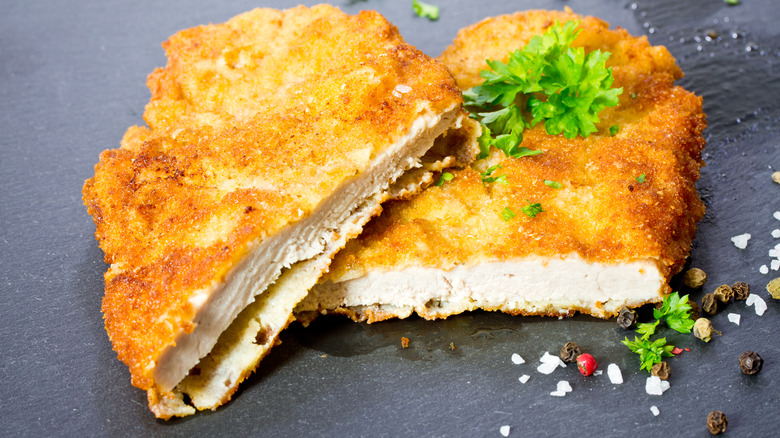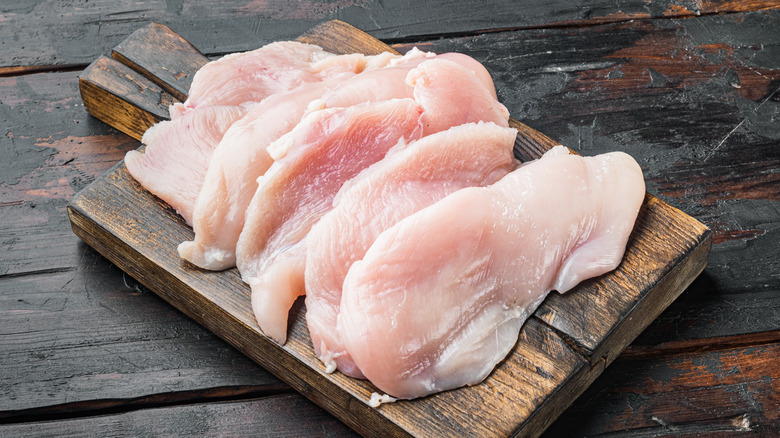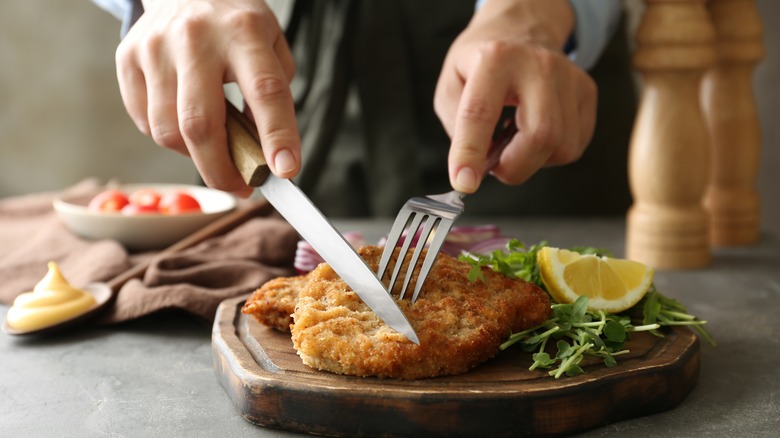The Common Mistake That Causes Burnt Chicken Cutlets
Opting for chicken cutlets in lieu of chicken breasts makes for a thinner, more evenly-cooked protein. Still, while cutlets do have their pros, they come with their own set of problems, too. Because this chicken must be sliced super thin, cooking them calls for a delicate balance between the pan's heat and the meat's thickness, and an uneven combination can easily lead to a burnt mess.
The one common mistake that causes these chicken cutlets to come out burnt might surprise you: You're cutting them too thick. To make a chicken cutlet, you simply need to slice a chicken breast in half evenly. This guideline is pretty general, leaving room for chefs to decide whether they want a thicker cutlet or a thinner one. Generally speaking, thinner cutlets cook faster, but also more evenly, while opting for thicker cutlets comes with a few more risks. Namely, even if your temperature settings are perfect, using too thick of a chicken cutlet can leave the outside burnt and the inside slightly raw or undercooked.
So, if you prefer a thicker chicken cutlet, simply opt for a lower temperature setting than normal so it will simmer and cook evenly. Even then, chicken cutlets are really supposed to be on the thinner side, so be diligent when cutting them to make sure they reach that ideal thickness.
How to cut the perfect chicken cutlet
To ensure you're cutting the flesh of your chicken cutlet thin enough, start with a sharp chef's knife. Next, lay your chicken breast flat on a cutting board and slice it horizontally. Try to do this in as clean a stroke as possible to avoid shredding the flesh. Now place your cutlet in a clean plastic bag and pound it out with the smooth side of a meat mallet. (You can also use a rolling pin.) Do this until the cutlet is even throughout. Pounding until you achieve a thickness of ¼ of an inch is a good rule of thumb. Repeat this process with all of your chicken cutlets until even, then get ready to cook.
If you prefer a thicker cutlet than ¼ of an inch, just be aware that they tend to cook unevenly. Plus, with the lower cooking temperatures required for them, the cutlets' breading might get soggy as it sits in the oil. (So, if you're frying your cutlet, making sure your oil is hot enough is essential for preventing burning.) Then, once you've successfully cooked your protein up just right, it's time to plate and serve.
How to use chicken cutlet
Now that you've mastered prepping — and cooking — your chicken cutlet, it's time to incorporate it into a meal. Chicken schnitzel with gravy is a common dish to make with cutlets, as is ever-iconic chicken parm. Still, for a few more off-the-wall options, here are some ideas.
Using chicken cutlets in a savory chicken Marsala is a great choice. While you could use thighs or breasts in this recipe instead, the thin nature of the cutlet will make for especially tender bites of protein that really soak up all the deep flavors of this dish. Next, adding some sliced chicken cutlet into a rice bowl is a great way to add some wholesome protein into the mix. Top any of these versatile bowls with a creamy avocado dressing for fresh flavor, or really spice things up with a few dashes of Worcestershire sauce. The choice is up to you.
Chicken cutlets are beloved for their thin texture, but a burnt exterior can ruin things for everyone. Make sure to cook them the right way, and from there, the recipe options are truly endless.


